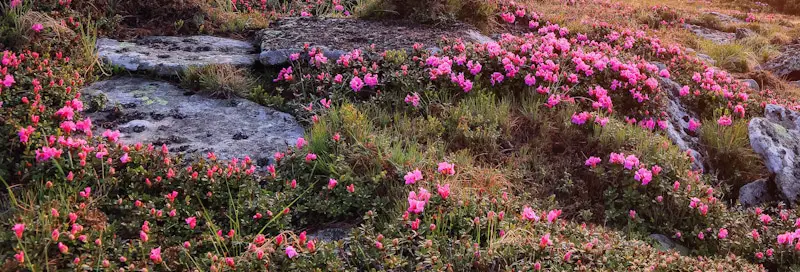Do you prefer an easy-care, no-mow landscape? If yes, then it is time to replace your conventional lawn grass with some ground cover plants. These plants are a fun and aesthetic way to cover the pesky bald spots and provide a fresh, green touch to your backyard.
Ground cover plants refer to evergreen, low-lying plants with broad, succulent leaves and striking, bright flowers that can sprawl across the ground and cover large areas. These longer-living plants can even survive winters and look good all year round.
These plants have hundreds of varieties. So whether you are searching for something for aesthetic considerations or practical purposes, ground cover plants have you covered.

What Are Ground Cover Plants?
Ground Cover Plants represent a group of low-growing plants that are well known for their creeping nature. They can be grasses, shrubs, ferns, annuals, strappy-leafed plants, trailing climbers, herbaceous perennials, or edible plants.
These plants are used to cover areas of your ground. They are economical and easy to maintain. Usually, these plants are shade-tolerant and hence grow evenly.
They also come in numerous sun-loving varieties, so you can choose the right plant depending on the climate, landscape, and other requirements.
Benefits Of Ground Cover Plants
Still uncertain about covering your backyard with groundcovers? Aside from being the ultimate ornamentals, these plants provide a multitude of benefits.
Easy To Maintain
Sure, a traditional lawn looks neat, but it requires lots of time, energy, and maintenance. Moreover, these lawns are only restricted to even terrain or places where your lawn mower can function. In comparison, groundcovers can be planted on slopes, banks, or any type of land. Unlike a classic lawn, they do not require mowing or frequent watering sessions. And if you want your space to stand out, you might want to ditch your traditional grass and try a different, exotic combination of plants.
Can Tolerate High Traffic
The grass may look neat, but it is delicate and can get easily damaged by high traffic. This does not mean that you should leave these areas uncovered. Substituting sturdy ground covers such as creeping thyme or Irish moss can form a dense carpet over your soil so that you don’t have to constantly worry about people dragging their feet in your yard.
Eliminates Weed
Another advantage of ground covers is that their roots spread out as they grow, which can choke out weeds and suppress their growth. Sedum is a great option to keep weeds at bay while simultaneously livening up the vibe of your garden with its intense crimson color.
Prevents Erosion
Ground covers are also an excellent way to control erosion. With their roots running deep and anchoring the soil, they can hold it back and protect it during rainy days.
Eases Transition
These plants act as buffer zones between the indoors and your lawn. When planted in masses, they can mimic the openness of a lawn and soften the appearance of your driveway, patio, or footpath.
Varieties Of Ground Cover Plants
Now that we have covered the advantages of these plants let’s move on to their different varieties and their respective benefits.
Ground Covers For Full Sun
These sun-soaking plants can stand long days and prosper with five to eight hours of sunlight every day. Not only do these ground covers require less water than grass, but they also help retain the soil water and keep it slightly cool. These full sun plants can also inhibit weed from germinating and prevent its spread.
From flowering plants to shrubs and perennials, sun-loving ground covers come in all shapes and sizes.
Ground Covers For Shade
The plants are perfect for covering the shady corners of your yard where nothing seems to grow. Aside from enhancing the look, these ground covers can also add fragrance and prevent weed. So, if your garden receives low light, you should plant these ground covers as they need less than four hours of sunlight to develop.
Drought-Tolerant Ground Covers
With these plants, you can fill up the places that are less moist, such as portions of rocks or dirt. Likewise, if you live in a dry climate, you can trust these ground covers to thrive without requiring much water during the growing season.
Walkable Ground Covers
Sometimes called the stepables, these ground cover plants are sturdy and resilient enough to tolerate foot traffic while sprucing things up in the greenery department. And since this variety stops growing at a particular height, you can say goodbye to pruning, trimming, or the more tedious tasks like mowing.
Evergreen Ground Covers
These plants should be your priority if you prefer a green lawn all year round. They provide charm to your lawn in winter, when other plants are dormant, and protect the soil from insects, weeds, and erosion. Let’s not forget about their bloom power. Most of these low-level plants yield elegant flowers during the growing period, which are adored by many.
Best Ground Cover Plants For Your Outdoor Space
With so many options available in the market, it can be challenging to find the right plant for your space. To help you make this decision, we have stated some of our favorites which will undoubtedly provide your yard with a variety of colors and textures.
Cotoneaster Horizontalis
One commonly used sun-loving ground cover is Cotoneaster Horizontalis. This shrub grows best in full sun or part shade and needs loamy, moist soil to reach its full potential. In addition, the red berries and pink flowers of Cotoneaster can amp up your outdoor space by bringing something other than the basic green.
Creeping Thyme
Creeping thyme is a stepable ground cover that can grow in moderate to partial shade areas. It is known for its beautiful foliage and purple flowers, which produces a calming fragrance in your garden and can also be used as an edible herb.
Angelina Sedum
Angelina Sedum, also known as the stone crop, is one such ground cover that does not need frequent watering and can grow even in the aridest environment. This evergreen perennial exhibits golden-green foliage throughout the year and its small yellow summer flowers, which complement the golden leaves. In fall and the less rainy months, the leaves may fade away and turn rusty oranges that can make Sedum outshine other plants.

Creeping Jenny
Creeping Jenny is a popular choice for walkable ground covers. It grows well under direct light, or little shade can withstand high foot traffic, and is simple to maintain unless you don’t let them dry out completely. This plant produces pretty, golden flowers resembling coins and is also referred to as Moneywort.
Ajuga Reptans
Ajuga Reptans, or bugleweed, stand around eight to ten inches and are dotted with massive leaves and beautiful blue, purple, bronze, and even variegated flowers. They are effective in hiding blown-in debris and stacking out weed seeds. If you want to see your green around the year, these plants should be your priority.
Conclusion
We hope this article answered all your questions regarding Ground Cover Plants and gave you a detailed description of their varieties and enough options for your next pick. Remember, these plants are a smart way to cover your space and can take your gardening game up a notch.
Victoria is the owner and main author of hobby plants. She loves spending her free time in her garden planting and taking care of her plants. Victoria hopes you enjoy the content here!

![The Types of Prayer Plants: [Varieties Explained] The Types of Prayer Plants: [Varieties Explained]](https://www.hobbyplants.com/wp-content/uploads/2022/09/types-of-prayer-plants-300x158.jpg)
![The Types of Ice Plants: [Varieties Explained] The Types of Ice Plants: [Varieties Explained]](https://www.hobbyplants.com/wp-content/uploads/2022/09/types-of-ice-plant-300x158.jpg)
![Bleeding Heart Plant Varieties [COMPLETE BEGINNER'S GUIDE] Bleeding Heart Plant Varieties [COMPLETE BEGINNER'S GUIDE]](https://www.hobbyplants.com/wp-content/uploads/2022/07/bleeding-heart-plant-300x158.jpg)
![Prayer Plant At Night: What Makes Them Unique? [EXPLAINED] Prayer Plant At Night: What Makes Them Unique? [EXPLAINED]](https://www.hobbyplants.com/wp-content/uploads/2022/07/prayer-plant-at-night-300x158.jpg)
![Why Are My Peace Lily Leaves Turning Brown? [EXPLAINED] Why Are My Peace Lily Leaves Turning Brown? [EXPLAINED]](https://www.hobbyplants.com/wp-content/uploads/2022/07/peace-lily-leaves-turning-brown-1-300x158.jpg)
![Why Does My Majesty Palm Have Brown Tips? [EXPLAINED] Why Does My Majesty Palm Have Brown Tips? [EXPLAINED]](https://www.hobbyplants.com/wp-content/uploads/2022/08/majesty-palm-brown-tips-300x158.jpg)
![Best Soil For A Money Tree? [DIFFERENCES EXPLAINED] Best Soil For A Money Tree? [DIFFERENCES EXPLAINED]](https://www.hobbyplants.com/wp-content/uploads/2022/08/best-soil-for-money-tree-300x158.jpg)
![What Causes Brown Tips on A Ponytail Palm? [EXPLAINED] What Causes Brown Tips on A Ponytail Palm? [EXPLAINED]](https://www.hobbyplants.com/wp-content/uploads/2022/08/brown-tips-on-ponytail-palm-300x158.jpg)


